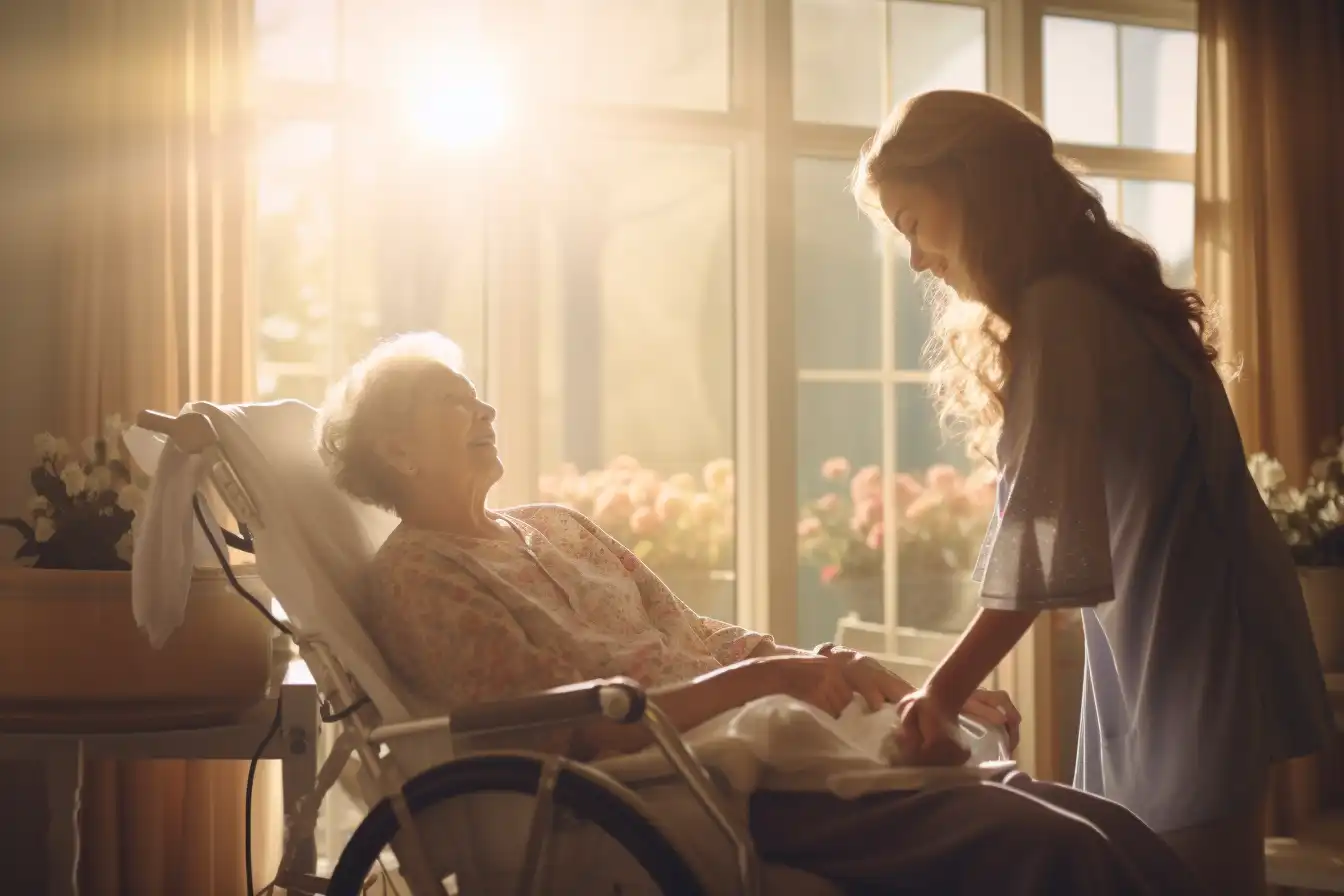How To Respond To Terminal Restlessness In Hospice Care
Experiencing terminal restlessness in a patient or family member in hospice care can be profoundly difficult and trying. This state is usual towards life’s end, typically manifesting as anxiety or distress.
This article aims to equip you with strategies to identify and effectively respond to terminal restlessness, thus bringing comfort during these critical moments. So, let’s dive in – better understanding awaits!
Key Takeaways
- Terminal restlessness is a condition that can occur near the end of life, causing anxiety and distress in hospice patients.
- To respond to terminal restlessness, it is important to identify the underlying issues, such as physical discomfort or medication side effects.
- Providing a calming presence by being present with the patient and offering reassurance can help alleviate their distress.
- Seeking support from professionals in hospice care, such as nurses and chaplains, can provide valuable guidance in managing terminal restlessness.

Understanding Terminal Restlessness in Hospice Care
Terminal restlessness in hospice care refers to a state of agitation and distress experienced by individuals as they approach the end of their life.
What is terminal restlessness?
Terminal restlessness happens to some sick people near the end of their life. It can make them feel worried or upset. They might be hard to calm down, or they may seem angry or mixed up.
This is not just being sad or mad, which can also happen when someone is very sick. It often comes and goes quickly and without warning. The person might look like they are in pain, but that’s not always why it happens.
Even things in their mind can cause this type of restlessness.

CONTINUA LEARNING
Simplify Your Hospice Team’s Training and Skill Building
A complete solution for your agency: more than 125 hospice courses, caregiver in-services, training plans, and more.
Symptoms and causes of terminal restlessness
People with terminal restlessness often act upset. They may show signs of worry, fear or anger. Sometimes they become confused and don’t know where they are. The person can seem very awake and not be able to sleep well.
They might also move a lot, like hand-wringing or fidgeting.
A few things cause terminal restlessness in hospice patients. Pain is one main cause. The person could have trouble breathing too. These make the person feel very bad and uneasy.
Feeling dehydrated or having an imbalance of body chemicals called electrolytes can lead to this state as well.
Some medicines like steroids used for cancer care, can trigger it too.
Other illness like dementia can also induce such behavior at the end-of-life stage.
So caregivers should keep an open eye on all these factors while providing aid to their loved ones in distress at the end of life stages.

Terminal restlessness vs. other end-of-life conditions
Terminal restlessness is a distinct condition that separates itself from other end-of-life conditions due to its unique symptomatology and root causes. Understanding these differences is critical for hospice nurses, caregivers, aides, and chaplains when providing the best care possible. The table below outlines the key differences between terminal restlessness and other end-of-life conditions.
| Condition | Symptomatology | Root Causes |
|---|---|---|
| Terminal Restlessness | Characterized by sudden shifts in behavior, including agitation, anxiety, anger, or confusion. It is common for individuals to exhibit restless or distressed behavior. | They may be a result of physical symptoms, such as pain or discomfort, or psychological factors. In some cases, pharmacological interventions may be necessary. |
| Other End-of-Life Conditions | These can encompass a range of emotional states, like depression or anger, which may be present throughout the end-of-life process, unlike terminal restlessness which often occurs suddenly. | Often linked to the emotional distress of the impending end of life, lack of control over the situation, or unresolved issues.Non-pharmacological interventions such as emotional support and creating a calm environment are often beneficial. |
Managing each condition requires a personalized approach, with collaboration between the healthcare team, the patient, and their family being essential. Understanding the differences between terminal restlessness and other end-of-life conditions can help ensure the appropriate strategies are employed to provide comfort and quality end-of-life care.
Strategies for Responding to Terminal Restlessness
To effectively respond to terminal restlessness, it is important to first identify the underlying issues causing the agitation.
Identifying underlying issues
To effectively respond to terminal restlessness in hospice care, it is crucial to identify the underlying issues causing the distress. Here are some key steps to help you identify and address these underlying issues:
- Observe changes in behavior: Pay close attention to any sudden shifts in behavior, such as increased agitation, anxiety, or confusion. These changes could indicate an underlying issue.
- Assess physical discomfort: Terminal restlessness may arise from physical discomfort caused by pain, difficulty breathing, urinary problems, or other symptoms. Consult with healthcare professionals to address these physical symptoms appropriately.
- Address psychological factors: Emotional distress or mental health issues can contribute to terminal restlessness. Provide emotional support and empathetic listening to help alleviate anxiety, depression, or other psychological factors.
- Consider medication side effects: Certain medications, including chemotherapy drugs or opioids used for pain management, may cause restlessness as a side effect. Collaborate with the healthcare team to assess and adjust medication regimens as needed.
- Evaluate electrolyte imbalances: Electrolyte imbalances, often caused by dehydration or steroid use, can lead to restlessness and agitation. Monitoring and addressing these imbalances can help manage terminal restlessness.
- Account for spiritual needs: Some individuals may experience spiritual distress during the end-of-life journey. Engage with chaplains or spiritual counselors who can offer guidance and support based on individual beliefs and preferences.
- Communicate with family members: Family members play a vital role in understanding their loved one’s needs and identifying potential triggers of terminal restlessness. Regular communication with them can provide valuable insights for developing effective interventions.

Providing a calming presence
When dealing with terminal restlessness in hospice care, one of the most effective strategies is to provide a calming presence. This means being present with your loved one or patient in a calm and comforting manner.
Sit quietly beside them, hold their hand, and offer reassurance through gentle words or soothing touch. Remain calm yourself, as your demeanor can have a significant impact on their state of mind.
Avoid showing signs of frustration or impatience, as this may escalate their agitation. Instead, speak softly and use a calm tone of voice to help create a peaceful environment. By providing a calming presence, you can help alleviate anxiety and distress for both the patient and their family during this challenging time.
Seeking support from professionals
Hospice care can be emotionally and physically demanding, especially when dealing with terminal restlessness. It is essential to seek support from professionals who have experience in managing this challenging symptom.
Hospice nurses, caregivers, aides, and chaplains can provide valuable guidance and assistance in understanding the underlying causes of terminal restlessness and developing effective strategies for addressing it.
They can offer practical advice on creating a calm environment, providing emotional support to both the patient and their loved ones, and identifying potential triggers or contributing factors.
How Hospice Care Can Help Address Terminal Restlessness
Hospice care offers a range of interventions, including social, psychological, spiritual, and physical support, to address terminal restlessness. Read on to discover how these interventions can help your loved one find calm and peace during their end-of-life journey.
Social interventions
In hospice care, social interventions can play a crucial role in addressing terminal restlessness. Here are some strategies to consider:
- Encourage the presence of loved ones: Having family members or close friends by the patient’s side can provide comfort and reassurance.
- Create a calm environment: Minimize noise and distractions, and ensure that the patient feels safe and secure in their surroundings.
- Engage in meaningful activities: Offer opportunities for the patient to participate in activities they enjoy, such as listening to music, reading aloud, or looking at photo albums.
- Provide emotional support: Offer a listening ear and empathetic presence. Sometimes, simply being there and validating the patient’s feelings can make a significant difference.
- Facilitate meaningful connections: Help connect the patient with any spiritual or religious resources they may find comforting, such as a chaplain or spiritual counselor.
- Foster communication: Encourage open and honest conversations between the patient, their loved ones, and the healthcare team. Effective communication can help address fears, concerns, and emotional distress.
- Coordinate support services: Collaborate with other members of the care team to ensure that additional support services, such as counseling or therapy, are available if needed.

Psychological interventions
Supporting the emotional well-being of individuals experiencing terminal restlessness is crucial in hospice care. As a healthcare professional, you can employ various psychological interventions to help ease their distress and promote comfort. Consider the following strategies:
- Active listening: Take the time to truly listen to the patient’s concerns and fears. Show empathy, validate their emotions, and provide reassurance.
- Validation therapy: Acknowledge and validate any delusions or hallucinations that the patient may be experiencing. Rather than dismissing or arguing against them, offer a comforting response that acknowledges their reality.
- Reminiscence therapy: Encourage patients to share memories or engage in activities that allow them to reflect on their life experiences. This can provide a sense of purpose, meaning, and peace during their end-of-life journey.
- Music therapy: Use soothing music or familiar songs that hold personal significance for the patient. Music has been shown to reduce anxiety, promote relaxation, and evoke positive emotions.
- Art therapy: Engage patients in simple art activities such as coloring or creating collages. The creative process can serve as a form of self-expression and provide a sense of control and accomplishment.
- Spiritual support: Offer spiritual guidance or connect patients with chaplains who can address any existential concerns they may have. Spiritual interventions can provide comfort and help patients find solace during this difficult time.
- Family involvement: Encourage family members to participate in therapy sessions or engage in meaningful conversations with their loved ones. Their presence and support can have a significant impact on the patient’s emotional well-being.
Spiritual interventions
Spirituality holds significant importance for individuals receiving hospice care, especially during the end-of-life journey. Addressing spiritual needs can help provide comfort and support during times of terminal restlessness. Here are some strategies to consider:
- Encourage spiritual practices: Encourage the patient and their loved ones to engage in spiritual practices that align with their beliefs. This may include prayer, meditation, or reading sacred texts.
- Provide emotional support: Offer a listening ear and be present to provide emotional support when discussing existential concerns or questions related to faith and spirituality.
- Engage in meaningful conversations: Initiate conversations about the patient’s life experiences, values, and personal beliefs. These discussions can bring comfort and a sense of purpose during the dying process.
- Facilitate connections with religious leaders: If desired, help coordinate visits from chaplains or spiritual leaders who can offer guidance, perform rituals, or provide sacraments based on the patient’s religious traditions.
- Create a sacred space: Set up a designated area within the patient’s room where they can find solace and practice their faith privately. This space can include religious symbols or items that hold personal significance.

Physical interventions
To address terminal restlessness in hospice care, there are various physical interventions that can help provide comfort and support to patients. These interventions focus on addressing any physical symptoms or discomfort that may be contributing to the restlessness. Here are some strategies for physical interventions:
- Ensure a comfortable environment: Create a calm and soothing atmosphere in the patient’s room by reducing noise levels, controlling lighting, and maintaining a comfortable temperature.
- Promote relaxation: Encourage the use of relaxation techniques such as deep breathing exercises, gentle massage, or listening to calming music. These activities can help promote relaxation and reduce restlessness.
- Manage pain and discomfort: Work closely with the healthcare team to assess and manage any pain or discomfort the patient may be experiencing. Administer prescribed pain medications as directed and provide regular monitoring to ensure effective pain management.
- Maintain hygiene and comfort: Regularly attend to the patient’s personal hygiene needs, including changing soiled clothing or bedding, ensuring cleanliness, and providing adequate hydration and nutrition.
- Assist with mobility: Help patients move around if they are able to do so safely. Encourage gentle exercises or repositioning to prevent stiffness and improve circulation.
- Provide assistance with toileting: Offer timely assistance with toileting needs to prevent discomfort due to urinary or bowel issues.
Conclusion
In conclusion, responding to terminal restlessness in hospice care requires a comprehensive approach that addresses both the physical and emotional needs of the patient. By identifying underlying issues, providing a calming presence, and seeking support from professionals, caregivers can help alleviate agitation and distress.
Hospice care offers various interventions, including social, psychological, spiritual, and physical support to address terminal restlessness effectively. Remember that collaboration between the healthcare team and the patient’s family plays a crucial role in developing an individualized plan for managing terminal restlessness in hospice care.
FAQs
What is terminal restlessness in hospice care?
Terminal restlessness in hospice care refers to a state of agitation or outburst that may occur when death approaches in individuals with a terminal illness.
How can I spot the signs of terminal restlessness?
Recognizing terminal restlessness involves noting changes like delirium, outbursts and other symptoms of terminal unrest in patients receiving palliative care.
What causes this condition known as ‘terminal agitation’?
The causes of what we term ‘terminal agitation’ are not fully understood yet but it often comes up as death draws near due to an individual’s response to their illness.
Can home health and hospice help with managing these symptoms?
Yes, both home health services and hospice can offer aid for treating the symptoms of terminal restlessness, providing comfort during this tough stage.
In what ways does palliative care lend support with terminal angst?
Palliative care provides relief by easing physical discomfort linked to symptoms, supporting emotional well-being and offering guidance through events like this sort.
How long does end of life restlessness last?
The duration of end-of-life restlessness can differ among patients, usually lasting from several days up to a week before passing away.
What does it mean when a hospice patient is restless?
When a hospice patient is restless, it often signifies that they are experiencing physical or emotional discomfort, and it may indicate that the end of life is approaching.
How do you calm a restless hospice patient?
To soothe a restless hospice patient, a blend of symptom-relief medications and emotional backing from healthcare providers and family is often effective.
Is restlessness part of end of life?
Yes, experiencing restlessness is a frequent symptom for many individuals who are in the end-of-life phase.
Which signs would you notice if the end of life is near?
Signs that the end of life is imminent often include heightened restlessness, altered breathing, and reduced alertness.
How do you calm someone in hospice?
Easing someone in hospice frequently involves giving prescribed medications and emotional reassurance through comforting touch or calming words.
Can terminal restlessness last for weeks?
Although uncommon, terminal restlessness can persist for weeks but is generally a sign that manifests closer to the end of life.
What does end of life restlessness look like?
Restlessness at the end of life may appear as physical fidgeting, emotional unease, or frequent shifts in body posture.
What is the terminal restlessness stage?
The stage of terminal restlessness refers to a time of increased emotional and physical agitation that frequently occurs as life nears its end.
How long does restlessness last before death?
The period of restlessness usually spans from several days to a week before death, although individual experiences may vary.
Is it normal for a dying person to be restless?
Yes, it’s typical for individuals nearing the end of life to go through episodes of restlessness.
Does terminal restlessness mean death is near?
While terminal restlessness often suggests that death may be imminent, it’s not an absolute indicator and should be considered alongside other symptoms.
What causes restlessness at end of life?
Factors like pain, side effects of medication, and emotional turmoil can contribute to restlessness at the end of life.
How do you calm an agitated hospice patient?
To alleviate agitation in a hospice patient, a combination of prescribed medications and emotional comfort through soothing words or touch is often employed.
How do you keep a hospice patient comfortable in bed?
Comfort in bed for a hospice patient can be achieved by adjusting pillows, using soft linens, and administering pain-relieving medications.
Can my loved one be comforted?
Absolutely, measures like medication, emotional support, and a tranquil setting can offer comfort to your loved one during their hospice stay.
How successful will control of terminal restlessness be?
Effectiveness in controlling terminal restlessness can vary but is often successfully managed with a balanced approach of medication and emotional care.
Hospice care & comfort (palliative) care: what’s the difference?
Hospice care is centered on providing comfort at the end of life, whereas palliative care focuses on symptom management and can be given at any illness stage.
How long does terminal agitation last before death?
The duration of terminal agitation generally ranges from a few days to a week before death, although individual experiences can differ.
How can you predict the end of life?
Forecasting the end of life is complex but may include observing indicators such as increased restlessness, altered breathing patterns, and reduced responsiveness.
